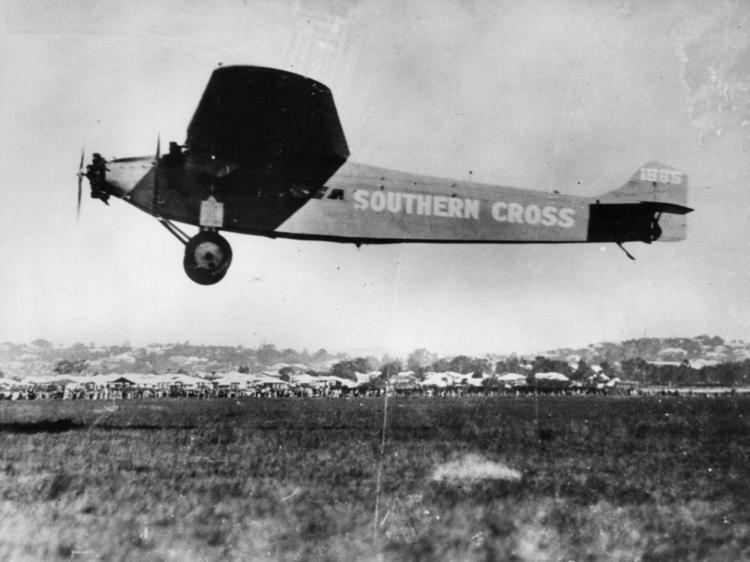 | ||
Southern Cross is the name of the Fokker F.VIIb/3m trimotor monoplane that in 1928 was flown by Australian aviator Sir Charles Kingsford Smith, Charles Ulm, Harry Lyon and James Warner in the first ever trans-Pacific flight to Australia from the mainland United States, about 11,670 kilometres (7,250 mi).
Contents
History
The Southern Cross began life as the Detroiter, a polar exploration aircraft of the Detroit News-Wilkins Arctic expedition. The aircraft had crashed in Alaska in 1926, and was recovered and repaired by the Australian expedition leader, Hubert Wilkins. Wilkins, who had decided the Fokker was too large for his Arctic explorations, met with Kingsford Smith and Charles Ulm in San Francisco and arranged to sell them the aircraft, without engines or instruments.
Having fitted the aircraft out with engines and the other required parts, Kingsford Smith made two attempts at the world endurance record, in an attempt to raise funds and interest for his trans-Pacific flight. However, after the New South Wales government withdrew its sponsorship of the flight, it looked as if the money would run out and Kingsford Smith would have to sell the Southern Cross. The aircraft was bought by American aviator and philanthropist Allan Hancock, who then loaned it back to Kingsford Smith and Ulm.
Trans-Pacific flight
On 31 May 1928, the crew—Charles Kingsford Smith, Charles Ulm, and Americans Harry Lyon (navigator) and James Warner (radio operator)—took off from Oakland, California, United States. The Southern Cross first stopped for rest and refuelling in Hawaii before setting off for Fiji. This leg of the journey took 34 1⁄2 hours of flight across open seas before gliding past the Grand Pacific Hotel in Suva, where a large and enthusiastic crowd saw the first aircraft to land in Fiji touch down at Albert Park. The Southern Cross landed at Eagle Farm Airport in Brisbane, Queensland, Australia, on 9 June, where a crowd of 25,000 people were waiting to greet the Southern Cross on its arrival at the airport. The Southern Cross flew on to Sydney the following day (10 June).
The aircraft was in constant radio communication with ships and shore during the flight using four transmitters and three receivers powered by a propeller driven generator attached to the fuselage below the cockpit. Transmitters included one 50 watt short wave operating at 33.5 meters and two 60 watt transmitters operating at 600 meters with one 600 meter emergency, waterproof set capable of operating eight hours submerged. Receivers, sharing a common audio amplifier, included a short wave, long wave and beacon. The first paid commercial messages were sent and received during the flight and a new world record distance for radio was set with a short wave reception at Bloemfontein, South Africa the long way around the world at 12,800 miles (20,599.6 km). Direct short wave aircraft to shore communications were maintained with the Pacific Coast until the flight was four hours out of Honolulu which had been monitoring the flight from two hours of its departure with a similar reception overlap on the Honolulu to Suva leg. Success on this flight influenced Admiral Byrd to equip his three Antarctic Expedition aircraft with similar equipment.
Trans-Tasman flights
Kingsford Smith, Ulm, and Sir Gordon Taylor also made the first nonstop Trans-Tasman flight in the Southern Cross – over the Tasman Sea from Australia to New Zealand and back – beginning with the first crossing on 10–11 September 1928, a distance of 2,670 kilometres (1,660 mi). Guy Menzies completed the first solo trans-Tasman flight in the Southern Cross Junior in 1931.
Preservation
Shortly before Kingsford Smith's death in 1935, he sold the Southern Cross to the Commonwealth of Australia, for display in a museum. The aircraft was brought out of retirement briefly in 1945 for the filming of the movie Smithy. The machine was refurbished in 1985 under the supervision of Jim Schofield, a senior aviation civil servant and air crash investigator. The Southern Cross is now preserved in a special glass hangar memorial on Airport Drive, near the international terminal at Brisbane Airport.
A full-sized flying reproduction of the Southern Cross was built in South Australia between 1980 and 1987, and is the largest known reproduction aircraft in the world. Sergeant Anthony Lohrey of the Royal Australian Air Force, Aircraft Research and Development Unit (ARDU) oversaw its construction. On 25 May 2002 at Parafield South Australia she lost a main wheel on takeoff. The replica was landed on the one good wheel and the tail, with the pilot keeping the damaged wheel off the ground by keeping the single wing high in the air. When the aircraft stopped the high wing came down and snapped off ~3 m of the wing tip. After considerable negotiation the Historical Aircraft Restoration Society (HARS) acquired the aircraft from the SA Government in 2010, and the aircraft was transported to HARS Albion Park facility. The replica aircraft is being restored to full airworthy status by HARS volunteers including the handcrafted all wooden spruce and plywood wing. The aircraft carries the original registration of VH-USU.
A personal tribute
Australian aviation enthusiast Austin Byrne was part of the large crowd at Sydney's Mascot Aerodrome in June 1928 to welcome the Southern Cross and its crew following their successful trans-Pacific flight. Witnessing this event inspired Byrne to make a scale model of the Southern Cross—scaled 1.27 cm to every 30.48 cm (a half inch to the foot) of the Southern Cross—and made mostly from brass finished in gold and silver plating. Kingsford Smith disappeared before Byrne had completed the model.
After Kingsford Smith's disappearance, Byrne continued to expand and enhance his tribute with paintings, photographs, documents, and art works he created, designed or commissioned. Between 1930 and his death in 1993, Byrne devoted his life to creating and touring his Southern Cross Memorial.
